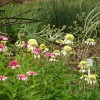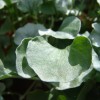Jun
08
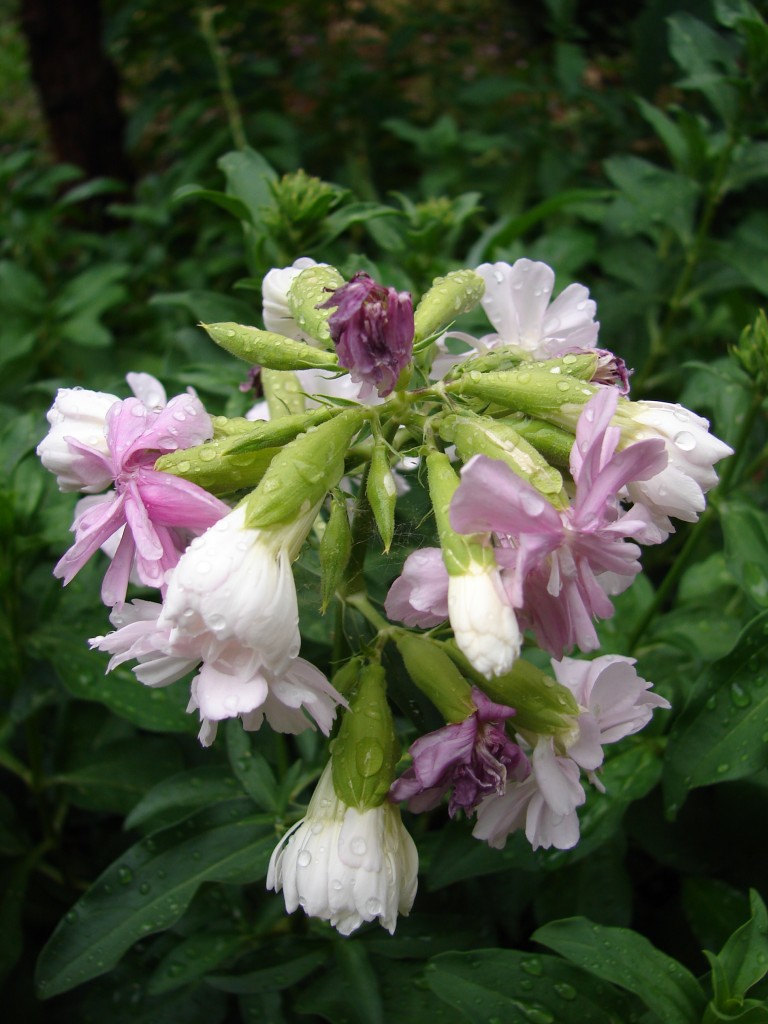
Bouncing Bet
Bouncing Bet, or Soap Wort (Saponaria officianalis), is a fragrant perennial that blooms from late spring all the way until fall. It likes morning sun and afternoon shade. It is drought tolerant, but likes a bit more moisture if it can get it. If it looks like the bloom is petering out, you can cut it back to encourage a second blooming. It was originally from Europe, but can now be found all over the U.S.
Bouncing Bet contains saponins which foam when mixed with water which makes a really cool make-shift soap, but it also makes this plant poisonous to animals that graze on it. The seeds hold the most toxin, but the entire plant is poisonous. Most animals will avoid it. In fact, nothing seems to eat it in my garden – not even insects.
-- Weather When Posted --
- Temperature: 85°F;
- Humidity: 47%;
- Heat Index: 85°F;
- Wind Chill: 85°F;
- Pressure: 29.87 in.;
Jun
08
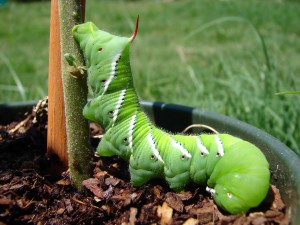
Tomato Horn Worm
Check out this big guy! He is a tomato hornworm or the caterpillar phase of the Hummingbird Moth, which are way cool when you see them. They really do look like (and as big as) a hummingbird. It is in the Order Lepidoptera, family Sphingidae, genus and species Manduca sexta. This guy was about 2 1/2 inches, but they can get as big as four inches. I suspect that he had quite a bit more growing to do. And now I know what has been happening to my tomato seedlings. Luckily, they were volunteers that I had dug up and not yet found a home for.
The Tomato Hornworm loves tomatoes, potatoes, eggplant, green peppers… basically anything in the nightshade plant family. The moths sip nectar and very important in the polination of night blooming flowers. They are also quite a site to behold, but the catterpilar can lay waste to a tomato plant in no time. I’m ahead of the game, though. I have so many tomatoes planted that there is no way he can eat them all! If you can, try to dedicate one plant to them in a covered tent just to see the moth.
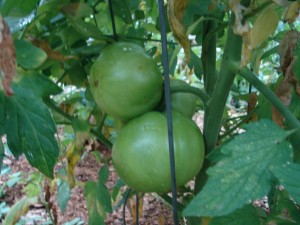
Beefmaster Tomato
If you just can’t live with him, you can kill the poor thing by introducing parasitic wasps or letting the birds at him. Braconid wasps, Trichogamma wasps, skunks, birds and lizards all love to dine on him. You can also spray with BT (Bacillus thuringiensis) which is a bacteria that infects the caterpillar, but it is easier to just pick them off by hand. there is usually only one or two around.
I think they are fun! Besides… I have plenty of tomatoes, if they will only ripen.
-- Weather When Posted --
- Temperature: 88°F;
- Humidity: 39%;
- Heat Index: 88°F;
- Wind Chill: 88°F;
- Pressure: 29.82 in.;
Jun
05
This has been another crazy week of non-stop activity, obligations, events… No time in the garden and I’m exhausted. I did manage to make a few finds, though. It’s too dark to get pictures now, but I will try to take some this weekend and get them up.
OK… so here is this week’s list:
- Roses – the are starting to recover from the black spot.
- Dahlberg Daisies

Tuscan Sun Rosebud
- Scarlett Sage
- Trailing Purple Verbena
- Elderberry
- Gulf Coast Penstemon
- Poke Salad
- Tomatoes
- Peppers
- Blackberry
- Lambs Ear
- Marigolds
- Borage
- Mealy Blue Sage
- Pentas
- Bear’s Breach
- Impatiens
- Red Oxalis
- Petunias
- Vinca (white)
- Zebra Plant – this is new!
- Vitex – the butterflies love this tree!
- Sweet Lavender

Lanatana
- Calibrochoa
- Star Jasmine
- Santolina
- Snap Dragons
- Oxeye Daisies
- Passion Flower
- Purple Lantana
- 4 O’Clocks
- Purple Crape Myrtle
- Cleome
- ‘Sweet Kate’ Spider Wort
- ‘Black and Blue’ Anise Sage
- Pomegranate
- Lemon Balm
- St. John’s Wort
- Wine Cups
- Cantaloupe
- Prairie Phlox
- Cannas
- Pink Oxalis
- Bouncing Bet
- Summer Poinsetta
- Purple Cone Flowers
- Esperanza
- Cucumbers
- Coral Honey Suckle
- Althea
- Buddleia

Buddleia - Honeycomb Butterfly Bush
- Coleus
- Russian Sage
- ‘Confetti’ Lantana
- Watermelon
- Bouncing Bet
- Yellow Daylily
- Sundrops
- Yellow Squash
- Zucchini
- African Daisy
- ‘Lil’ Business’ Daylily
- Asters
- Hollyhocks
- Geraniums
- Cosmos
- Snow Peas
- Strawberries
- Allysum
- ‘Australian Skies’ Anise Sage
- Autumn Coral Sage
- ‘Autumn Joy’ Sedum
- Ajuga
- Althea – just started blooming.
- Sunflowers – now it is officially summer!
- Cilantro
- Parsley
- Bougainvillea – this is new for our anniversary. John loves bougainvillea.
-- Weather When Posted --
- Temperature: 77°F;
- Humidity: 48%;
- Heat Index: 79°F;
- Wind Chill: 77°F;
- Pressure: 29.92 in.;
Jun
05
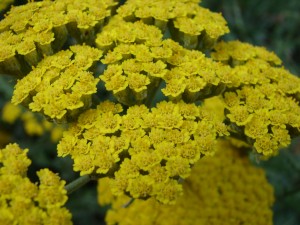
Santolina
Santolina (Santolina chamaecyparissus) is also called Lavender Cotton and is originally from Europe. It is actually an herb that is evergreen in my garden but would be perennial further north. It’s hard to tell in this picture, but the foliage is actually a silver/grey and the flower and foliage both hold up will for cutting.
The leaves have a wonderful, almost lavender, smell when brushed or crushed. I love the smell, but evidently moths don’t. One of the herbal uses for Santolina is as a moth repellant.
This is a very drought tollerent plant. About the only problem you might have with it is if the soil doesn’t drain well enough. It loves the extremely hot dry weather and full sun and will bloom all summer long. I like to deadhead it a bit when it starts looking too leggy.
-- Weather When Posted --
- Temperature: 77°F;
- Humidity: 48%;
- Heat Index: 79°F;
- Wind Chill: 77°F;
- Pressure: 29.92 in.;
Jun
04
It’s really not that hard. All you have to do is fill a container about half way with compost and then fill it the rest of the way with water. Then just let it sit. And sit… After a couple of weeks, you can dilute it to spray on your plants as a foliar feed. You will need to strain the mixture or you will just end up clogging your sprayer and cussing. A bit of old panty hose works really well wrapped over the mouth of a bottle and held on by a rubber band. Dilute the mixture down until it sort of looks like tea… about one part concentrate to anywhere from five to ten parts water.
-- Weather When Posted --
- Temperature: 80°F;
- Humidity: 37%;
- Heat Index: 80°F;
- Wind Chill: 80°F;
- Pressure: 29.95 in.;
Jun
04
Oh good grief! I just can’t catch up! I barely got anything done in May off my list of chores so most of it will have to carry over to June. I am, however, calling in extra troops – I’m going to have 1-2-Tree to limb up and thin all the trees. That will be a huge help. And if we can get rid of the defunct boat, I can have them deliver a load of mulch while they are at it. Then it will just be a matter of finding the time to get the mulch out.
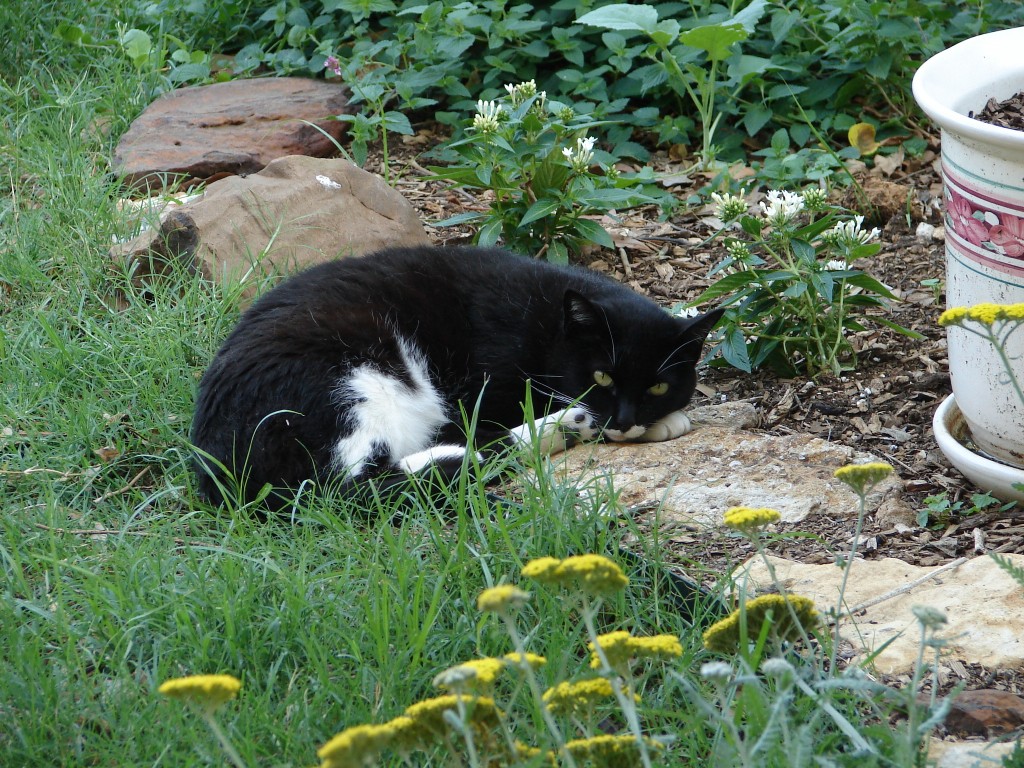
KC Napping
So here is the list…
- Continue spraying weekly with baking soda spray to treat roses for black spot and crape myrtles for fungus.
- Continue foliar feeding weekly with Garrett Juice, Seaweed or Compost Tea.
- Continue mowing weekly and get mower blades sharpened (still).
- Continue to clean and treat the pond weekly.
- Deadhead any flowers that look leggy or worn out.
- Mulch all beds. I MUST get this done before the temps get too high!
- Dig out the forsythia (still).
- Build new compost rings (still).
- Feed and water the birds.
- Begin watering weekly where needed – especially the veggies!
- Finish building a bed around the chicken coop. MUST get rid of that Bermuda grass. That is the worst weed in my garden! I have also found out that it is one of the biggest allergens in my garden.
- Dig out the Johnson grass clumps and reseed with Buffalo grass.
- Apply second treatment of nematodes to control ants, fleas, grubs, ticks, chiggers…
- Harvest veggies! We have already gotten a few cherry tomatoes, yellow squash, sweet peas, green beans, and cucumbers. Yeah!
- Time to plant Zinnias. I still have some seed I saved from last year. What I really want to get is some more Xeranthamums! Those were pretty!
- WEED, WEED, WEED!
I need to find a pretty (and big) pot to plant the bouganvilla that we got to commemorate our anniversary. I also need to find some nice creepers to plant between the pavers to the pond and chicken coop. Four more okra would be nice too. I only see one that has come up from the seed I saved. Maybe I can still find some (on sale even)? I would also like to find a “Whale’s Tongue” agave. We saw one at the arboretum and it is so cool – and it’s drought tollerant! Oh! And a weeping Blue Atlas Cedar (in a pot). The ones at the Arboretum were gorgeous! My luck, though, I would probably kill it. Things in pots, don’t you know.
We are looking into putting in drip irrigation but with so many other things happening right now, I’m guessing that is one project that will have to wait. We are also getting gutters installed (finally!) and hope to get some REAL rainbarrels (and not just trash cans) to help with the watering.
Something is happening to the hyacinth bean vine. I’m not sure what, but I will try to figure out what to do about it. It’s dying back from the tip. Hmm… The apple tree is also suffering. I think it has fire blight. I need to treat it with the sick tree treatment and prune back any dead spots. I think it got sick because the cats stressed it out by clawing it. I will try to cage the trunk to get them to stop that.
OK… let’s see if I do any better through June than I did in May!
-- Weather When Posted --
- Temperature: 80°F;
- Humidity: 37%;
- Heat Index: 80°F;
- Wind Chill: 80°F;
- Pressure: 29.95 in.;
Jun
02
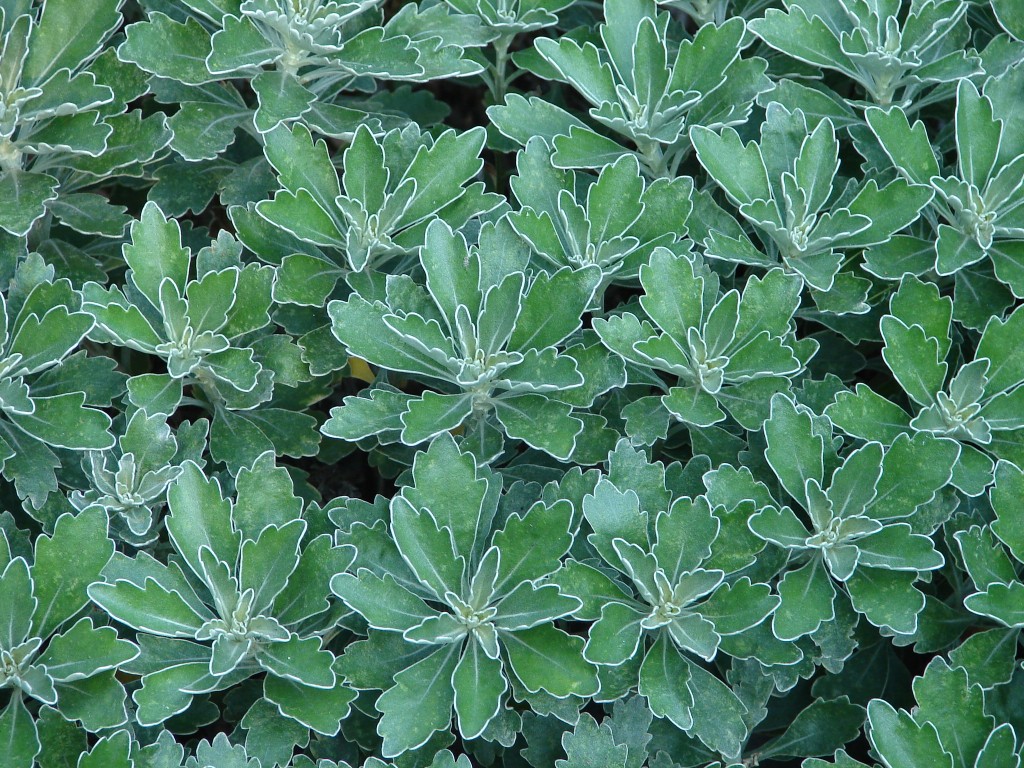
Ajania
Ajania (Chrysanthemum pacifica) is a really neat type of chrysanthemum that is grown for it’s folliage rather than for its flower. It is a low mounding perennial (almost evergreen in my yard) for full sun that is very drought tolerant. It does have small yellow flowers in the late summer summer or early fall, but it they aren’t much. The lobed leaves are beautiful though.
This is another plant that was given to me by a friend and it took me a long time to actually figure out what it really is. Ajania is originally from Asia, but it does well here and is not invasive. I haven’t found any problems with this plant – no bugs, not fungus – nothing. It’s lovely.
-- Weather When Posted --
- Temperature: 85°F;
- Humidity: 47%;
- Heat Index: 85°F;
- Wind Chill: 85°F;
- Pressure: 29.88 in.;














